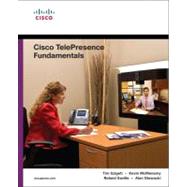
What is included with this book?
Tim Szigeti, CCIE No. 9794, is a technical leader at Cisco within the Enterprise Systems Engineering (ESE) team, where he has spent the last decade specializing in quality of service technologies. His current role is to design network architectures for the next wave of media applications, including TelePresence, IP video surveillance, digital media systems, and desktop video. He has coauthored many technical papers, including the Cisco Enterprise QoS Design Guide and the Cisco TelePresence Network Systems Design Guide, and the Cisco Press book End-to-End QoS Network Design. Tim holds a bachelor of Commerce degree in management information systems from the University of British Columbia.
Kevin McMenamy is senior manager of technical marketing in the Cisco TelePresence Systems Business Unit (TSBU). Kevin has been doing technical marketing at Cisco since February 2000, focused primarily on voice- and video-related technologies, including Cisco IP/TV, Cisco H.323 video conferencing, Cisco IP Telephony, and Unified Communications, and now Cisco TelePresence. Prior to Cisco, Kevin worked at FVC.COM, which manufactured H.321 video conferencing solutions, and at Winnov L.L.P, which manufactured the video capture cards used in the Cisco IP/TV streaming servers and in PCs for Microsoft’s NetMeeting and WhitePine Software’s CUCME applications. Kevin has filed several U.S. patents with Cisco on voice and video signaling and security concepts and has coauthored and contributed to numerous technical papers including the Cisco IP Videoconferencing Design Guide, the Cisco IP Video Telephony Design Guide, the Cisco IP Telephony Design Guide, the Cisco Quality of Service Design Guide, the Cisco SAFE Blueprint, Cisco CallManager Fundamentals, and most recently the Cisco TelePresence Network Systems Design Guide.
Roland Saville is a technical leader within the Cisco Enterprise Systems Engineering (ESE) team. For the past 13 years at Cisco, he has focused on a broad range of technology areas, including VoIP, security, wireless, RFID, and TelePresence as a systems engineer, consulting systems engineer, and technical marketing engineer. He has coauthored many technical papers including the Cisco SAFE Blueprint documents, Cisco TelePresence Network Systems Design Guide, and several U.S. patents relating to RFID technology. Roland holds a bachelor of science degree in electrical engineering from the University of Idaho and a master of business administration from Santa Clara University.
Alan Glowacki is a technical marketing engineer in the TelePresence Systems Business Unit (TSBU). Alan has been working on video communications since 1995 when he joined First Virtual Communications as employee number 20. After five years with First Virtual Communications, Alan joined Cisco, focusing on H.323 video conferencing. During his time with Cisco, he authored many technical papers including the first H.323 Videoconferencing Solution Reference Design Guide. After three and a half years with Cisco, he left to try another startup only to return to Cisco in 2006. Upon his return to Cisco, Alan returned his focus to video by joining the TSBU.
| Introduction | |
| Cisco TelePresence Overview | |
| The Cisco TelePresence eXperience (CTX) | |
| TelePresence Physical Design | |
| Room Requirements | |
| Case Study 1 | |
| Physical Room Design | |
| Installation Logistics | |
| Case Study 2 | |
| Installation Logistics | |
| TelePresence Network Infrastructure Design | |
| Connecting the Endpoints | |
| Network Deployment Models Introduction | |
| TelePresence Network Service Level Requirements | |
| TelePresence QoS Design Best-Practices | |
| Place-in-the-Network TelePresence QoS Design | |
| Case Study 3 | |
| Enterprise & Service Provider QoS Design for TelePresence | |
| Securing TelePresence | |
| Case Study 4 | |
| Secure TelePresence Design | |
| Multipoint | |
| Case Study 5 | |
| TelePresence Multipoint Design | |
| Business to Business Connectivity | |
| Case Study 6 | |
| Business-to-Business TelePresence Design | |
| TelePresence Interactive Services Design | |
| Call Processing | |
| Call Admission Control | |
| CallManager Deployment Models | |
| Case Study 7 | |
| TelePresence CallManager Design | |
| Calendaring Integration | |
| Case Study 8 | |
| Calendaring Integration | |
| TelePresence Operations, Administration and Management | |
| TelePresence Operations | |
| Concierge Services | |
| Managing the Endpoints | |
| Case Study 9 | |
| TelePresence Endpoint Management | |
| Cisco Network Management Applications for TelePresence | |
| Case Study 10 | |
| Managing TelePresence Networks | |
| Collaboration Applications | |
| Interoperability | |
| Pre-Qualification Checklist | |
| Room Assessment Checklist | |
| Network Path Assessment Checklist | |
| Table of Contents provided by Publisher. All Rights Reserved. |
The New copy of this book will include any supplemental materials advertised. Please check the title of the book to determine if it should include any access cards, study guides, lab manuals, CDs, etc.
The Used, Rental and eBook copies of this book are not guaranteed to include any supplemental materials. Typically, only the book itself is included. This is true even if the title states it includes any access cards, study guides, lab manuals, CDs, etc.